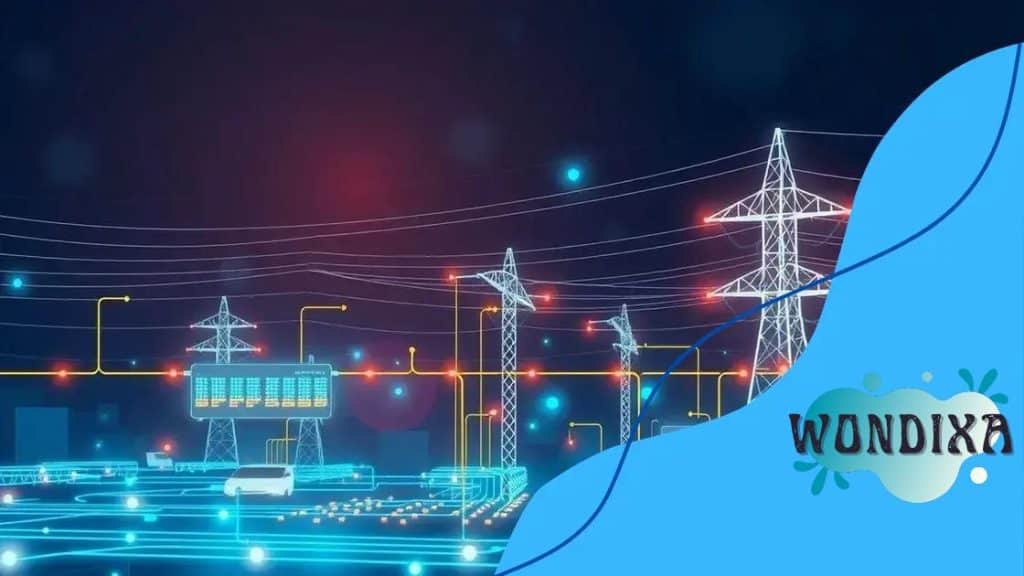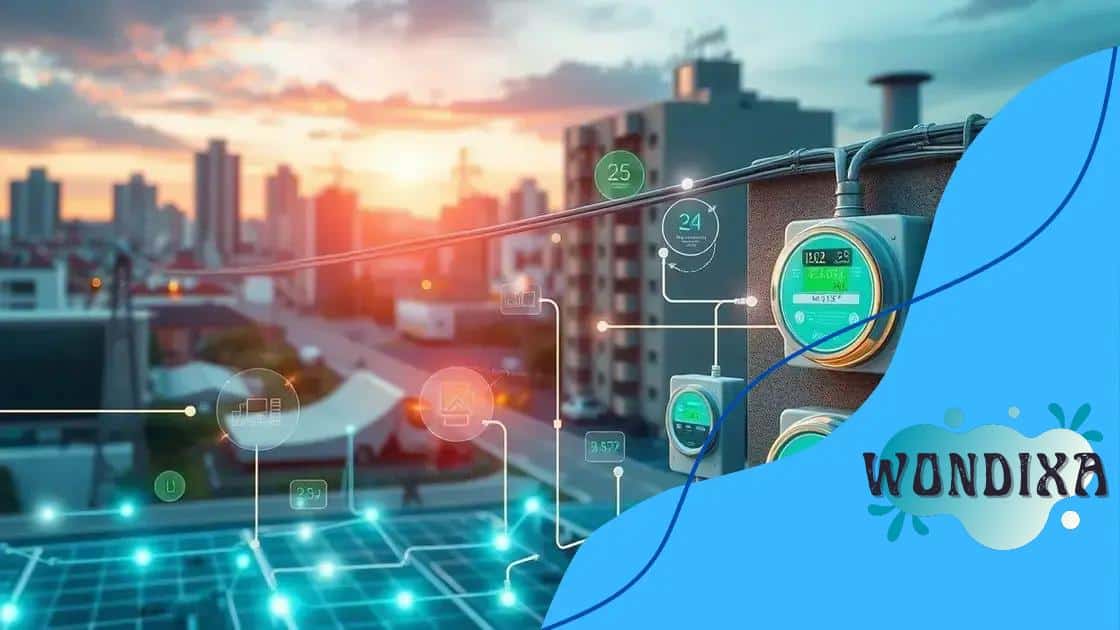Smart grid technologies revolutionizing energy use

Smart grid technologies revolutionizing energy use enhance efficiency, empower consumers, and facilitate renewable energy integration, providing a sustainable solution to modern energy management challenges.
Smart grid technologies revolutionizing energy use are at the forefront of transforming our energy landscape. Have you considered how these innovations could affect your daily energy consumption? Join me as we explore their impact on efficiency and sustainability.
What are smart grid technologies?
Smart grid technologies are innovative systems designed to enhance energy management and efficiency. They utilize digital communication tools to improve the reliability and integration of the energy supply. By connecting various components of the energy system, these technologies enable better monitoring and control of energy resources.
Key Components of Smart Grids
The framework of smart grids encompasses various elements that work in harmony. These components include:
- Smart Meters: Devices that provide real-time data on energy consumption.
- Advanced Sensors: Instruments that monitor grid performance and detect issues instantly.
- Data Management Systems: Platforms that analyze usage patterns and help utilities optimize energy distribution.
- Renewable Energy Integration: Systems that facilitate the connection of solar and wind energy sources.
This interconnected approach is vital for modern energy networks. As demand for energy increases, smart grid technologies help utilities respond swiftly to fluctuations in consumption.
Benefits of Smart Grid Technologies
Implementing these systems can lead to significant improvements. For instance, reduced outages and enhanced response times are some of the main benefits. Utilities can quickly identify problems and reroute power as needed. Moreover, consumers are empowered with better information, enabling them to make informed decisions about their energy use.
Furthermore, the integration of renewable resources marks a pivotal shift in how we generate and consume energy. Smart grids facilitate the addition of solar panels and wind turbines, driving sustainability.
Thus, smart grid technologies are reshaping our energy landscape, making it more efficient and responsive. As these systems evolve, they hold the key to achieving a sustainable energy future.
Benefits of smart grids for consumers
The benefits of smart grids for consumers are vast and impactful. These technologies not only enhance the reliability of energy delivery but also empower consumers with better control over their energy usage. By providing real-time data, smart grids allow households to make informed decisions about their consumption patterns.
Enhanced Energy Management
One of the significant advantages of smart grids is improved energy management. With access to detailed information about energy usage, consumers can adjust their habits to save energy and money. For instance, when energy prices are lower during off-peak hours, households can shift their energy-intensive activities, like running the dishwasher or charging electric vehicles, to those times.
- Cost savings: Lower bills from energy-efficient practices.
- Real-time alerts: Notifications about usage spikes or outages.
- Environmental impact: Encouragement to shift towards renewable energy sources.
Moreover, smart grids facilitate the integration of renewable energy sources like solar and wind power. Homeowners with solar panels can sell excess energy back to the grid, creating new income opportunities and community benefits.
Improved Reliability and Resilience
Smart grids lead to a more reliable energy supply. They can detect and manage outages faster than traditional grids. This immediate response minimizes downtime during power disruptions. In addition, smart grids improve overall system stability by balancing demand and supply effectively.
As a result, consumers experience fewer outages and better service quality. They also gain insights into their energy usage trends, helping them identify areas for further savings and efficiency advancements.
In conclusion, smart grids create a win-win situation for consumers by delivering cost savings, enhanced control over energy use, and fostering sustainable energy practices.
How smart grids enhance energy efficiency

Smart grids play a vital role in enhancing energy efficiency across various sectors. By utilizing digital technologies, they optimize the delivery and consumption of electricity. This not only reduces waste but also promotes sustainability. With real-time data and advanced monitoring systems, smart grids help identify inefficiencies and continuously improve performance.
Real-Time Monitoring and Control
One of the significant features of smart grids is the ability to monitor energy use in real-time. This immediate feedback allows both utilities and consumers to see how energy is being consumed at any given moment. With this information, adjustments can be made to reduce unnecessary energy consumption. Customers can also receive alerts regarding their peak usage times, making it easier to shift their energy habits.
- Peak load management: Reduces strain on the grid during peak times.
- Automated demand response: Engages systems to lower usage when demand is high.
- Enhanced grid stability: Minimizes the risk of outages through better demand prediction.
As a result, both energy providers and consumers benefit from a more balanced energy flow, which leads to significant cost savings. This savings is essential as it can be reinvested into further sustainable initiatives.
Integration of Renewable Energy Sources
Smart grids facilitate the smooth integration of renewable energy sources like wind and solar power. By allowing these sources to be fed directly into the grid, they help diversify the energy supply. This leads to a more reliable and resilient energy network. Furthermore, smart grids can better match renewable energy production with consumer demand.
In addition, the use of smart technologies enables energy storage solutions, which can hold energy generated during low-demand periods. This stored energy can then be used when demand is higher, leading to a more efficient overall system. Therefore, smart grids not only improve energy efficiency but also help in the transition to a more sustainable and clean energy landscape.
Challenges in implementing smart grid technologies
Implementing smart grid technologies comes with several challenges that can hinder progress. Despite their many benefits, the road to efficient energy management is not always smooth. Key hurdles include high initial costs, technological complexities, and regulatory issues that can arise during implementation.
High Initial Costs
One of the primary challenges is the high initial investment required to modernize existing infrastructures. Upgrading to smart grid technologies often demands significant financial resources for new equipment and systems. Many utilities may struggle to justify these costs, particularly if the return on investment is not immediately clear.
- Equipment costs: Upgrading meters and substations can be expensive.
- Training and workforce: Skilled personnel are needed to manage new technologies.
- Consumer incentives: Encouraging users to adapt to new systems may require additional funding.
These investments can be daunting, especially for smaller utility companies or regions with limited budgets.
Technological Complexities
In addition to financial aspects, the technological complexity of integrating new systems poses challenges. Smart grids require advanced software, communication networks, and data management capabilities. Ensuring these components work seamlessly together is crucial but can be quite challenging.
There are also concerns about cybersecurity. As smart grids become more interconnected, they become more vulnerable to potential cyberattacks. Protecting sensitive data and maintaining trust among consumers is paramount.Developing effective security measures is essential but adds another layer to the implementation process.
Moreover, not all regions have the same level of infrastructure readiness. Areas with aging equipment may face additional barriers, making it difficult to implement smart grid solutions effectively.
In conclusion, navigating the myriad of challenges associated with smart grid technologies requires careful planning, investment, and collaboration among stakeholders.
The future of smart grids in energy management
The future of smart grids in energy management looks promising, driven by advances in technology and a growing emphasis on sustainability. As the demand for energy increases, smart grids will play a critical role in optimizing energy use across various sectors.
Innovations in Technology
Technological innovations are paving the way for more effective smart grids. Developments in artificial intelligence and machine learning will enable these systems to analyze vast amounts of data more efficiently. By predicting energy consumption patterns, smart grids can enhance their response to demands, aligning supply with real-time usage.
- Enhanced data analytics: Tools that provide insights into consumer behavior.
- Automated systems: Devices that optimize energy distribution without human intervention.
- Smart appliances: Household items that can communicate with the grid to save energy.
These innovations will help make energy management not only more efficient but also more user-friendly. Consumers will have greater control over their energy consumption, leading to further savings.
Sustainability and Renewable Energy Integration
Another crucial element in the future of smart grids is the seamless integration of renewable energy sources. As societies seek to reduce carbon emissions, smart grids will facilitate the use of wind, solar, and hydroelectric power more effectively. They will enable a decentralized energy production model, where homes and businesses can generate and share their energy.
In addition, smart grids will support energy storage solutions to balance the intermittent nature of renewable sources. This ensures that energy produced during peak sunlight or wind hours can be stored and used later, maximizing efficiency and sustainability. The result is a greener energy landscape that benefits both consumers and the environment.
As we look towards the future, the evolution of smart grids stands to revolutionize energy management, offering solutions that are efficient, sustainable, and user-oriented.
In conclusion, the evolution of smart grid technologies is reshaping how we manage energy. They offer numerous benefits such as improving efficiency, integrating renewable energy sources, and providing consumers with better control over their energy consumption. Although challenges exist in implementation, the potential rewards of a smarter, more sustainable energy future are immense. As these technologies advance, they will play a crucial role in building a greener world.
FAQ – Frequently Asked Questions about Smart Grid Technologies
What are the main benefits of smart grid technologies?
Smart grid technologies improve energy efficiency, empower consumers, and facilitate the integration of renewable energy sources.
What challenges are faced in implementing smart grids?
Challenges include high initial costs, technological complexities, and the need for effective cybersecurity measures.
How can consumers benefit from smart grids?
Consumers gain better control over their energy usage, receive real-time data, and can reduce costs through efficient energy practices.
What role do smart grids play in sustainability?
Smart grids support the transition to renewable energy by optimizing its integration and improving overall energy management, contributing to a more sustainable future.





